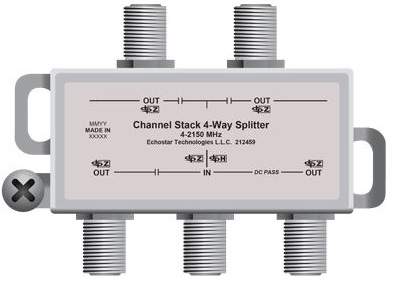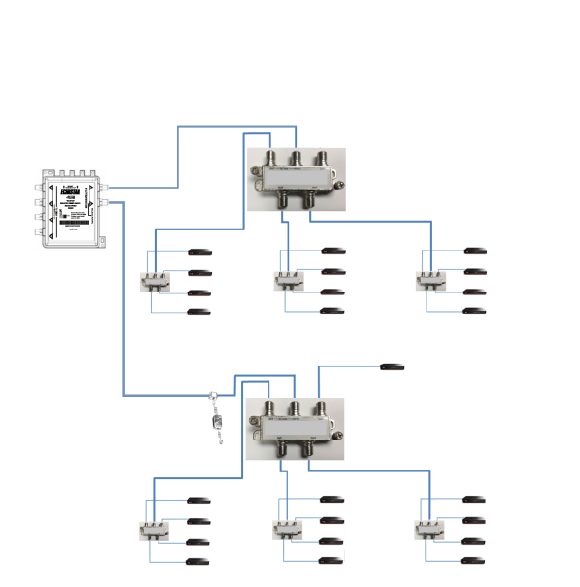Chances are if you're reading this article, you're looking at an upgrade to some fairly old DISH equipment. The ViP series of receivers from DISH were made from the mid-2000s until the late 2010s. There's still stock of the ViP222 out there, because it's a reliable receiver that just plain works.
But, it's not the latest and greatest device out there in the world of receivers (in other words, non-DVRs.) That title belongs to the Wally, a slick little receiver that takes the great stuff from the 222 series and builds on it.
With a Wally, you get the Hopper user interface and the Hopper Voice Remote. That means your internet-connected receiver can use the power of Google to control your TV watching experience. I think those two things alone are worth the price of admission. If you don't have a receiver yet, you'll want to start with a Wally. If you already have an older receiver and you're thinking of an upgrade, Wally is the way to go.
Like the Hopper, the Wally uses DISH's Hybrid technology. This is an improvement to the basic way that DISH satellite antennas work. In the past, DISH has used more or less off-the-shelf technology. The Eastern Arc and Western Arc dishes are unique to the service, but that's just because they aim at multiple satellites at once. It's generally been possible to use multiple 18″ round dishes and feed them into a multiswitch if that's what you want to do.
Hybrid technology adds another whole level of sophistication to the DISH experience. A single wire down from the dish feeds a Hopper 3 or Wally and allows the wiring to be simplified. In the case of Hoppers, this means that all 16 recording tuners are served by a single wire. In the case of Wallys, it means you can add a lot more receivers a lot more easily just by using splitters.

This is DISH's stacking splitter. It's designed to go from the output of a hybrid dish or hybrid multiswitch and allow you to attach multiple Wallys. This is DISH's own diagram of how it works:

You can feed up to 16 Wallys with one set of five splitters. The diagram above shows 12 off one splitter and 13 off the other, but you get the idea.
This is incredibly important to business customers with multiple receivers. With the older technology you needed one multiswitch for every four receivers and this new technology is so much easier and cheaper.
If you're happy with your existing 222s, then I wouldn't worry too much about it. But, if you're just starting out in your home, RV, or boat, you really should be starting with the current generation of hardware.
If you'd like to know more about how to add DISH programming to your life, call the experts! Solid Signal is a DISH Premier Local Dealer and we're here to make sure you get the absolute best customer service. Call us during East Coast Business Hours at 888-233-7563. If it's after hours, no problem! Fill out the form below. We'll get right back to you.
The post Is a DISH Wally really better than a ViP222? appeared first on The Solid Signal Blog.
Continue reading...
But, it's not the latest and greatest device out there in the world of receivers (in other words, non-DVRs.) That title belongs to the Wally, a slick little receiver that takes the great stuff from the 222 series and builds on it.
Here's what you get if you get a Wally:
With a Wally, you get the Hopper user interface and the Hopper Voice Remote. That means your internet-connected receiver can use the power of Google to control your TV watching experience. I think those two things alone are worth the price of admission. If you don't have a receiver yet, you'll want to start with a Wally. If you already have an older receiver and you're thinking of an upgrade, Wally is the way to go.
But that's not the real headliner here.
Like the Hopper, the Wally uses DISH's Hybrid technology. This is an improvement to the basic way that DISH satellite antennas work. In the past, DISH has used more or less off-the-shelf technology. The Eastern Arc and Western Arc dishes are unique to the service, but that's just because they aim at multiple satellites at once. It's generally been possible to use multiple 18″ round dishes and feed them into a multiswitch if that's what you want to do.
Hybrid technology adds another whole level of sophistication to the DISH experience. A single wire down from the dish feeds a Hopper 3 or Wally and allows the wiring to be simplified. In the case of Hoppers, this means that all 16 recording tuners are served by a single wire. In the case of Wallys, it means you can add a lot more receivers a lot more easily just by using splitters.

This is DISH's stacking splitter. It's designed to go from the output of a hybrid dish or hybrid multiswitch and allow you to attach multiple Wallys. This is DISH's own diagram of how it works:

You can feed up to 16 Wallys with one set of five splitters. The diagram above shows 12 off one splitter and 13 off the other, but you get the idea.
This is incredibly important to business customers with multiple receivers. With the older technology you needed one multiswitch for every four receivers and this new technology is so much easier and cheaper.
Does it really matter for home use?
If you're happy with your existing 222s, then I wouldn't worry too much about it. But, if you're just starting out in your home, RV, or boat, you really should be starting with the current generation of hardware.
If you'd like to know more about how to add DISH programming to your life, call the experts! Solid Signal is a DISH Premier Local Dealer and we're here to make sure you get the absolute best customer service. Call us during East Coast Business Hours at 888-233-7563. If it's after hours, no problem! Fill out the form below. We'll get right back to you.
The post Is a DISH Wally really better than a ViP222? appeared first on The Solid Signal Blog.
Continue reading...

